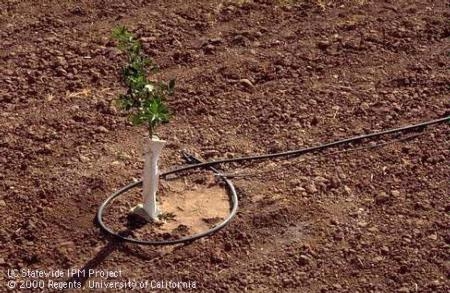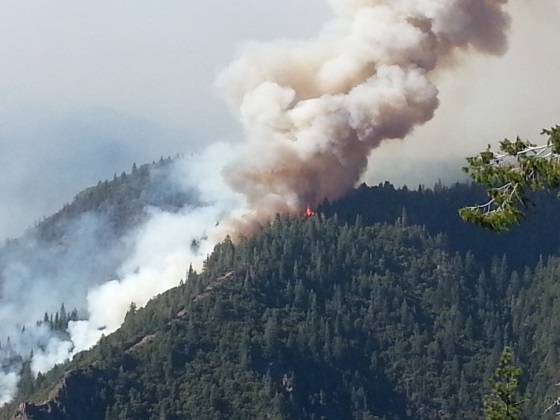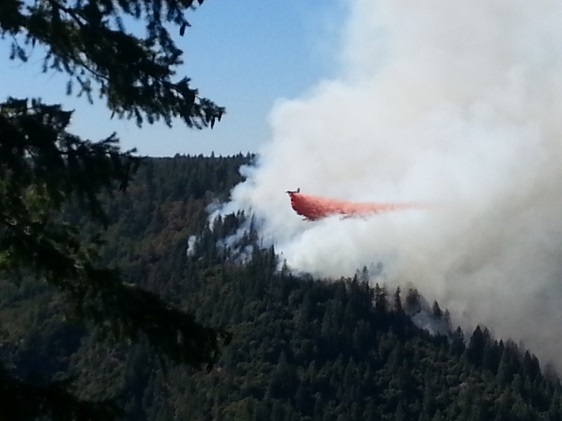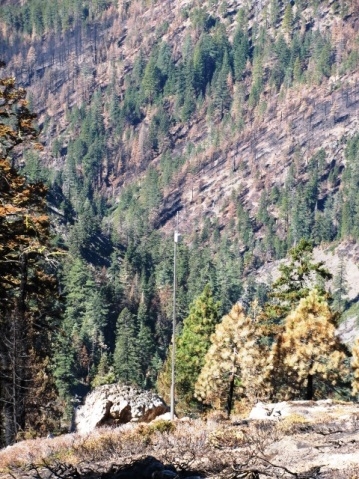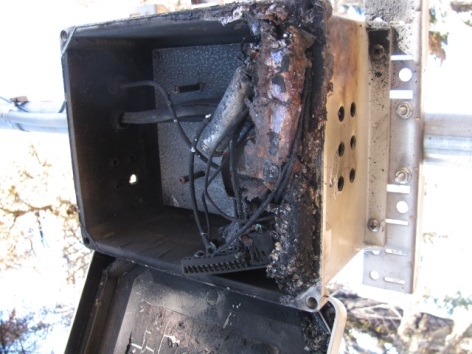UC Blogs
Meet Our Garden Heroes at Bohart Museum Open House on March 2
If there's anything better than a ladybug eating an aphid, it's a ladybug devouring dozens of aphids. Get 'em! Ladybugs--actually, they're "lady...
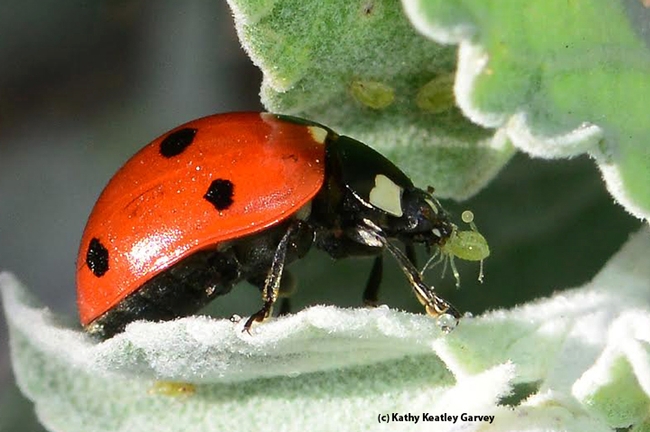
A ladybug grabbing an aphid. (Photo by Kathy Keatley Garvey)
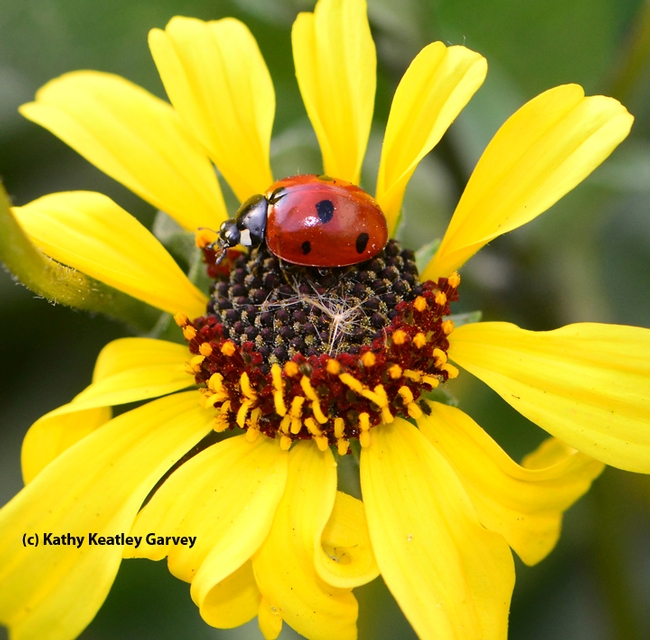
Ladybug prowling for aphids on brittlebush, Encelia californica. (Photo by Kathy Keatley Garvey)
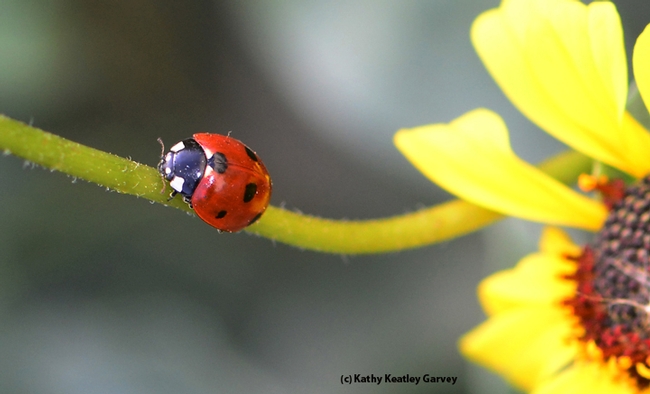
Ladybug "walking the line." (Photo by Kathy Keatley Garvey)
Succulent Foliage and Plant Forms
Good ground cover: Echeveria, Ice Plant, Sedum, Senecio
Large/decorative: Aeonium, Agave, Aloe, Cotyledon, Crassula, Dudleya, Echeveria, Kalanchoe, Portulacaria
Small, odd form to flowers: Aloe, some Crassula, Hoya, Ice Plants, Kalanchoe
Don't use too many kinds in one planting. Mass a few species instead of putting in one of each. Can combine with other plants that look right with them. Not all succulents like hot sun, and some do not thrive in summer heat even with some shade.
Distinctive foliage and plant forms:
Cotyledon undulata = looks like a pale green, delicately-carved porcelain
some Euphorbias = appear to have exploded to produce their contorted shapes
many Kalanchoes/Gasterias = handsome, mottled foliage
Aloes/Agave = sculptural quality of sword-shaped provides material of striking interest indoors and out
Echeveria = wide, various sizes and shapes. Miniatures to low-branched shrubs to plants with a single rosette of leaves atop a stem. Colors/textures of leaves (every shade of green dusted with red or purple or frosty white with tinges of pink or blue) make for a nice indoor decoration.
Crassula argentea (Jade) = bright green, rubbery leaves
C. aboresans = silvery foliage blotted with margined red
C. treibneri = pale yellow-green leaves that arrange themselves in a perfect cross
C. teres = carries its leaves in a tightly packed column
Dudleya pulverulenta = white leaves (D. candida, D. farinosa are smaller)
Kalanchoes = panda plant (K. tomentosa) = silvery plush leaves stained red at margins
K. marmorata (pen wiper plant) = heavily spotted gray-green leaves
Sedums = cockscomb, donkey tail, dragon blood sedum
Semperviviums= brilliantly colored with leaves tinted crimson or purple or edged in red
Some Aeoniums = have nearly black foliage tinted coppery or bronze-red
Velvet leaved kinds (like Echeverias) = powdery coating on leaves = is easily bruised
Succulents do not have harmful spines (except some euphorbias and a few aloes)
Flowers
Fig marigolds or ice plants are stunning in flowering season and make sheets of color
Agave/aloe = bright flowers on tall spikes
Wax plant (Hoya carrosa) = gracefully displays exotic waxy-white blooms in clusters on a vine-like plant
Euphorbia = usually inconspicuous, become showy when surrounded by colorful bracts as in the pointsetta (E. pulcherrine)
The diversified forms and colorings of succulents are beautiful, sometimes bizarre, but always interesting.
Drought rekindles farmers' interest in drip irrigation
Drip irrigation isn't a new technology, but the drought in California is giving farmers greater incentive to consider installing the proven water-conserving irrigation technique, reported the Merced Sun-Star.
The use of plastic emitters in drip irrigation began in 1956 on a Kibbutz in Israel, where, like California, water demand is perennially greater than supply. Drip was introduced into the United States in the early 1960s.
Sun-Star reporter Marina Gaytan spoke to Scott Stoddard, UC Cooperative Extension advisor in Merced County, to get his thoughts about the trend toward drip.
“You can get water savings by using drip, but often times what you're really getting is improved water use efficiency,” Stoddard said. “You've improved your yield for the same amount of water.”
According to a farmer quoted in the story, installing a one-year surface drip system costs about $400 per acre. Some farmers are installing buried drip irrigation, which runs about $1,500 per acre but will last for many years.
Farmers welcome recent rainfall
Ventura County Star
Even though springtime rainfall can cause molds to grow in strawberries, and splashing raindrops can spread fungal and bacterial pathogens, farmers are delighted with the wet weather.
"We're going to lose some fruit, but that's a small price to pay," said Oleg Daugovish, UCCE advisor in Ventura County.
Before the rain began to fall, Daugovish advised growers to apply protective fungicides and open up plant canopies to expose the inside of the plants.
Carpenter Bees Like Almond Blossoms, Too
We're accustomed to seeing honey bees pollinating the almonds. But carpenter bees do, too. We spotted a female Valley carpenter bee, Xylocopa...
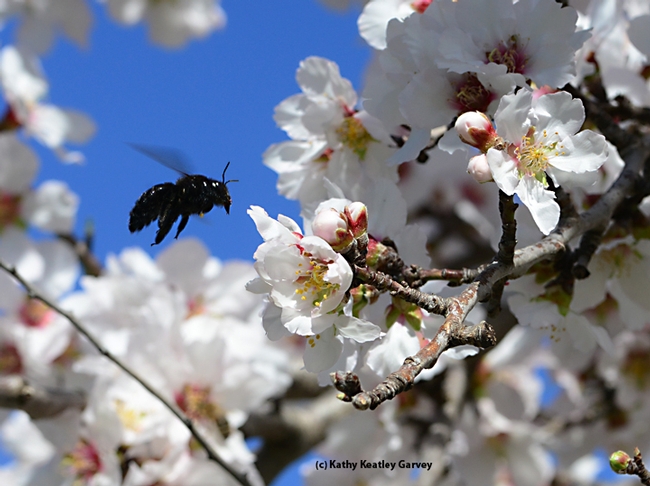
A female Valley carpenter bee buzzes in the almond blossoms. (Photo by Kathy Keatley Garvey)
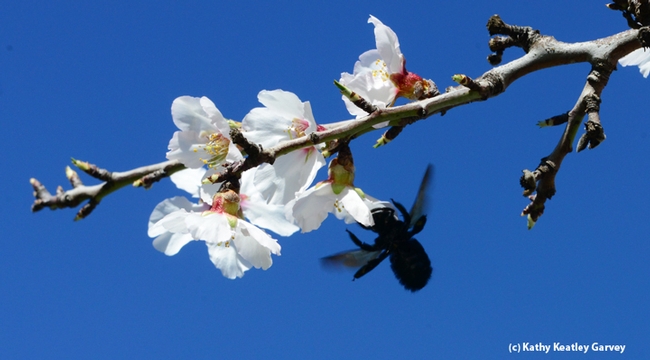
Full speed ahead: carpenter bee sights an almond blossom. (Photo by Kathy Keatley Garvey)
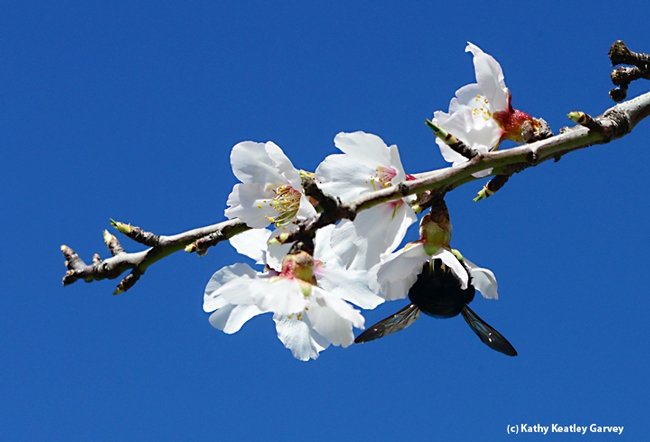
Female Valley carpenter bee meets almonds blossom. She's shaking her thoracic muscles to loosen the pollen. (Photo by Kathy Keatley Garvey)
What happens when a wildfire sweeps through your study area?
On Aug. 10, 2013, a wildfire started in a steep canyon on the Tahoe National Forest. When it was finally declared controlled on Oct. 8, the 'American Fire' as it was named, had burned approximately 27,440 acres, including half (1,100 acres) of the Sierra Nevada Adaptive Management Project (SNAMP) Last Chance study site.
Initiated more than 7 years ago, SNAMP is a collaboration project involving the University of California, UC Cooperative Extension, the US Forest Service, other state and federal agencies and the public that explores the effects of fuels reduction or thinning projects conducted by the Forest Service on forest health, fire behavior, water quality and quantity, wildlife (California spotted owl and Pacific fisher) and public participation. Scientists are using data collected from treated and untreated areas to model potential impacts of forest management. For example, fire modeling is being done to simulate what could happen in the event of a fire on the landscape. All of the science teams are integrating their results to provide forest managers with information that is relevant at the fireshed scale for future projects.
Before the American Fire broke out, work by the Forest Service on the Last Chance project treatment areas was mostly completed, including commercial timber harvesting, post-harvest surface fuels treatment and more than three-quarters of the prescribed fire acreage. UC forest researchers had resurveyed 99 percent of treated and untreated forest plots and were out in the forest working to complete the remaining plots when the fire started. The owl team had completed their surveys for the year at Last Chance and in the surrounding areas that comprise the regional study areas. The water team had in-stream monitoring equipment in place, as well as meteorological stations at several locations, recording and relaying data to UC Merced.
After the American Fire ignited west of the SNAMP study site, American River Ranger District staff ordered all science teams working in the area to evacuate. They removed several of the water team's wireless nodes that were threatened, along with the stream level monitoring equipment. They covered other equipment with fire blankets and bulldozed a defensive line around a meteorological station to keep the fire out of the immediate area.
Parts of the treated and untreated study areas in the Last Chance project, including completed thinning and prescribed burning units, were burned in the American Fire. Some of this area was intentionally backfired by firefighters to aid in fire management. The vast majority of the treated area burned at low severity with pockets of moderate severity. The decision to backfire through the middle of the Last Chance project was a direct result of the project's location and post-treatment fuel profile.
The final determination of how the vegetation survived the fire will probably not be made for another year since significant mortality can happen much later. There was one active spotted owl nest site on the fire perimeter and it was known to have juvenile owls. The site will be surveyed by the owl team in 2014. As a result of quick action by the US Forest Service, only one of the water team's wireless nodes was damaged by fire.
The SNAMP project comes to an end this year. Science teams are working with post-treatment but pre-fire data to complete their analysis, write individual chapters and create integration products. However at the same time, the American Fire provides a unique but fleeting opportunity to empirically examine the effects of fuels treatments. Thus planning is underway for further research at Last Chance to examine how wildfire under current management can transform ecosystem functions, and how to obtain desired results through novel fire management strategies. Adaptive management is analysis of an action, incorporation of new findings and adapting existing actions based on those results. SNAMP scientists want to take full advantage of the learning opportunities provided by the investment in SNAMP and the impacts of the American Fire at Last Chance.


